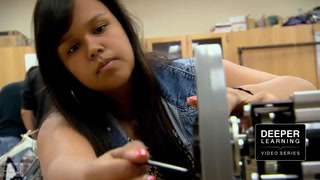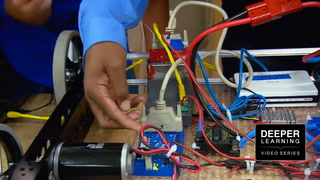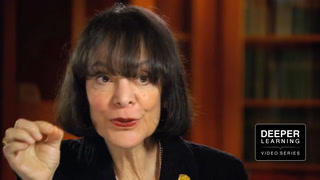Deeper Learning Through Linked Learning Transcript
Card:
Deeper Learning
Elevating Student Thinking and Student Voice
Card:
Deeper Learning Competencies
* Master core academic content
* Think critically and solve complex problems
* Work collaboratively
* Communicate effectively
* Learn how to learn
* Develop academic mindsets
+++ 00:00:31 +++
Student: Live robot.
Dave Yanofsky: If you look at the deeper learning core competencies we're talking about real-world application. It is not pursuing knowledge for knowledge sake.
+++ 00:00:43 +++
Michael Roach: Hello, 12th grade students from the School of Engineering and Sciences. Today we are here to listen to several interest groups speak.
Ken Davis: Takeaway academically is they're actually applying the things that they're learning in class. Swap it out with a bare motor just to make sure your program is good.
+++ 00:00:58 +++
Dave Yanofsky: Linked learning is taking the rigorous academic core and marrying it to a highly relevant technical component.
Dylan Besk: When you hit "run" on that program what do you think-- trick question-- is going to happen? What do you think's going to happen?
Student: Nothing.
+++ 00:01:12 +++
Dylan Besk: Engineering is a great field for people to study when they're young. If you've studied engineering you've solved problems, and there's no field any kid is ever going to get into that doesn't involve solving problems.
Card:
Deeper Learning Through Linked Learning
featured organization: ConnectEd
Card:
School of Engineering & Sciences
Sacramento, California
+++ 00:01:34 +++
Student: Live robot.
Lower Third:
Dave Yanofsky
Director of Media & Youth Development
ConnectEd, California
+++ 00:01:37 +++
Dave Yanofsky: I think if you look at the deeper learning core competencies we're talking about real-world application. It is not pursuing knowledge for knowledge sake independent of how it gets applied out into the world. Ultimately that's what we're all focused on, is how to empower these kids to be successful beyond school, and the only way to do that is to give them skills that are going to be transferable. We hope that students who graduate from linked learning pathways will be ready for college, career and life.
Lower Third:
Matt Turkie
Principal, School of Engineering & Sciences
Sacramento, California
+++ 00:02:04 +++
Matt Turkie: Our mission in the School of Engineering and Sciences is for high levels of learning for all students. It's also part of our mission to basically help influence the workforce of scientists and engineers and those in that field.
Ken Davis: Your question prep today deals with Assembly Bill 32. After that we'll break up into our groups.
Card:
12th Grade Robotics Class
+++ 00:02:25 +++
Matt Turkie: We're a linked learning school. We're linking in basically engineering and sciences in with the rest of the school, and they're linking in with the rest of the subjects, so subjects no longer work in silos. They don't work in isolation. They work as teams working on basically project-based learning.
Ken Davis: Today we should be at least deploying our robot code. Hopefully we can have them driving. I don't want to put any pressure on you, but we had two robots driving last class. I'm just saying.
Lower Third:
Ken Davis
12th Grade Engineering Teacher
School of Engineering & Sciences, Sacramento, CA
+++ 00:02:55 +++
Ken Davis: The project this morning revolved around Assembly Bill 32, which is a clean emissions bill, and the kids are taking that bill, and in engineering they're looking at electronic transportation. In their ELA classes they're doing research on the Assembly bill itself. Government class, they're analyzing the bill. They're going to do some debates in there. In their drama class they're actually making a video. And the culminating event is for them to create this electronic vehicle, which is a go-kart.
+++ 00:03:29 +++
Angel: Live robot.
Student: joystick. We have code here.
Student: Maybe it's locked up.
Ken Davis: It's locked up.
Student: Oh.
Ken Davis: Okay. Get another motor, just a bare motor. Swap it out with a bare motor just to make sure your program is good.
Angel: Okay.
Student: All right.
Angel: Our integrated unit is-- we're making solar cars, so it's like it involves every class.
+++ 00:03:49 +++
Student: So engineering, the whole build. English class, the writing prompts for the essay that goes to this whole build.
Angel: You have to have communication skills to present your idea.
Student: That's where drama class and English class come in.
Angel: Yeah.
+++ 00:04:05 +++
Ken Davis: Takeaway academically is they're actually applying the things that they're learning in class. You know, I hear "Oh, that's why we did that in class," and they're making that link from the academic coursework that they take and the actual project that they're working on.
Angel: Okay.
Student: Yeah? We're good?
Angel: Yeah. Okay.
Ken Davis: I think that's a success.
+++ 00:04:26 +++
Dave Yanofsky: One of the hits on linked learning potentially is that it is just a reskinned career and technical ed or voc ed experience, and it's important to really underscore that it is neither. It is a combination of both of those worlds, but it is taking the rigorous academic core and marrying it to a highly relevant technical component.
Card:
12th Grade Government Class
+++ 00:04:49 +++
Michael Roach: Okay. Hello, 12th grade students from the School of Engineering and Sciences. Today we are here to listen to several interest groups speak about Assembly Bill 32.
Card:
Interest Group: Pollution Solution
Woman: AB 32 was created in order to change people's views on greenhouse gases and their effects on society and the environment.
Card:
Interest Group: Alliance for Petroleum Security
Man: We don't want to cut jobs, but AB 32 will cause us to do so.
Lower Third:
Michael Roach
12th Grade Government Teacher
School of Engineering & Sciences, Sacramento, CA
+++ 00:05:12 +++
Michael Roach: We are doing a unit on interest groups, government interest groups and their influence on public opinion. We really looked at integrating it with the electric vehicle project that they were doing in their engineering class.
Student: Electric vehicles or zero-emission vehicles are the best solution for a variety of reasons.
Michael Roach: In government we thought it would be very important to look at legislation on what is helping push electric vehicles at a faster pace, and AB 32 is the natural legislation here in California to do that.
+++ 00:05:42 +++
Woman: People currently do not understand the impact we are having on our environment.
Michael Roach: The idea is they worked as a team to figure out a way to back up their arguments and find in-depth research, but we're also publicly speaking. We're critically thinking about the issues rather than just simply me giving them the information or them reading the information. They have to seek it out.
Student: A Washington Post survey revealed that a majority of Americans, six in 10, do not think climate change is an imminent threat in their lifetimes.
+++ 00:06:10 +++
Matt Turkie: The work we're doing here is a lot more authentic. Common Core is all about depth, so we feel we're preparing kids pretty well for that, because what we do is real, is authentic and is deep.
Student: We urge you to overcome a sea of tactics and seek the truth. Only then can we do what is best for America.
Card:
7th Grade Engineering Class
+++ 00:06:34 +++
Dylan Besk: Let's quickly go over the opener. When you hit "run" on that program what do you think-- trick question-- is going to happen? What do you think's going to happen?
Student: Nothing.
Dylan Besk: Huh. JJ.
JJ: Nothing.
Dylan Besk: Nothing. You're all brilliant, because you got it right.
Dave Yanofsky: School of Engineering and Science is a little unique in the sense that there is a high school and a middle school on the same campus.
Dylan Besk: What we're going to do today is we are going to set-up a data table, and we are going to cut some blades for those wind turbines.
+++ 00:07:02 +++
Dave Yanofsky: So the kind of mindset of being an engineer is starting to get inculcated into these students at a younger grade. It provides a technical through-line.
Dylan Besk: What dimension do you think this might be that makes it four square inches?
Student: About an inch.
Dylan Besk: Okay. So you think it might be an inch?
Lower Third:
Dylan Besk
7th Grade Engineering Teacher
School of Engineering & Sciences, Sacramento, CA
+++ 00:07:21 +++
Dylan Besk: Engineering is a great field for people to study when they're young even if they're not at all interested in engineering really, because if you've studied engineering you've solved problems, and there's no field that any kid is ever going to get into that doesn't involve solving problems. One of the blades is going to be one by what to get four?
Student: One times four.
Student: One by four.
Dylan Besk: One by four inches. What else would equal four?
Student: Two by two.
+++ 00:07:47 +++
Dave Yanofsky: We know that when students are learning math oftentimes there's a struggle because it's disconnected. They don't see the real-world applications. So the students-- early on they're starting to see how math gets applied through these engineering concepts, such as a wind turbine.
Student: We're thinking about two by two, but how would the blade look like if it's two by two?
Dylan Besk: If it's two by two your blade is going to be a square.
Student: One of the blades is two by two and the other one one by four.
Dylan Besk: Your results would be invalid.
Student: Oh, you can only do one variable?
+++ 00:08:16 +++
Dylan Besk: Exactly. You can only change one variable at a time. I think that our students will go to their next level with a degree of confidence that will get them through the tough classes, the projects that are difficult that has someone saying that something's impossible and them knowing that it's not impossible and persevering. You guys did a great job of dividing your labor. I love how you had them do something and you're doing something else. That's cool.
Card:
10th Grade CAD Class
+++ 00:08:43 +++
Ken Davis: You're going to have to go back and edit this extrusion so that it extrudes symmetric, all right? So you see how the data plane is in the center?
Matt Turkie: Going on to 10th grade they do computer-aided design, so CAD, which is a must as far as engineering goes. Everybody uses it.
Ken Davis: The main reason to do CAD is you want to design before you build. That's really a hard concept for kids to grasp, is you want to put all the design work upfront, the calculations, the actual CAD design, and then you build.
+++ 00:09:16 +++
Elena: Now click up here, the modify button. Now click "regenerate," because you don't want it to regenerate. So the top one's 42.
Ken Davis: When the students are engaged with each other and they're helping each other and they're teaching each other that's where it tends to stick, and that's where the learning occurs.
Elena: It is complicated.
Student: Yeah.
Elena: If you're not familiar with it it's very complicated.
Lower Third:
Elena
12th Grade Student Mentor
School of Engineering & Sciences, Sacramento, CA
+++ 00:09:40 +++
Elena: I know when I was a sophomore I struggled with this class with the same problems, and I just kind of got stubborn, so I know I liked it a lot when I had Mr. Davis just sitting there helping me. So if he needs help I'll just sit here with him until he finishes all of it and he has everything done.
Ken Davis: Your radius here is three. Radius here is 20.
Dave Yanofsky: We're seeing higher graduation rates. We're seeing higher passage of the exit exam, higher CST scores, higher attendance rates, less disciplinary problems, so we are seeing compelling evidence that this approach is working.
Card:
Robotics Club
+++ 00:10:17 +++
Ken Davis: They're there before school, they're there during lunch, they're there after school, especially if there's a big project.
Angel: and then push it?
Josh: Yeah, plug it in and then hit the circuit breaker. Okay. And then, yeah, it just goes up. Now can you ?
Angel: No, we're good.
Ken Davis: Sometimes I have to remind them "Hey, I got to go home now." Actually just run this guy here and it's going to configure it for you.
Angel: Oh, okay.
Lower Third:
Josh/Angel
12th Grade Students
School of Engineering & Sciences, Sacramento, CA
+++ 00:10:45 +++
Josh: Why are we here at four o'clock in the afternoon? Well, with something like this it's so interesting that it kind of keeps your interest.
Angel: It's for the thing we love, so of course we'll stay. Jackote [ph?], sit down.
Jackote: All right.
Josh: The experience you get from working on stuff like engineering, it really kind of sticks with you for a lifetime. Things you learn you can apply to many other things later on in life.
Jackote:
Angel: Live robot.
Josh: Sorry. I'm going backwards.
Angel: Well, that's actually pretty fun.
+++ 00:11:14 +++
Ken Davis: They're really into it. We're not making paper planes and boats made out of two-liter bottles, you know. No, we're making real boats and we're making real robots and we're solving real problems. It looks like it's taking a turn. That's pretty good.
Josh: It's actually really easy.
+++ 00:11:34 +++
Dave Yanofsky: Students are going to need to be good communicators. They're going to need to be good collaborators. They're going to need to be good problem solvers. These are the skills and aptitudes that students will need to take with them as they progress, and that's what linked learning and deeper learning are really intended to produce, students with those outcomes and with those skills that are transferable and applicable.
#### End of connected_deeper_learning_linked_learning_fc_640x360.mp4 ####














2 Comments
clestine caffie Sep 19, 2017 10:15pm
Ellen Wilson Mar 27, 2014 12:55am